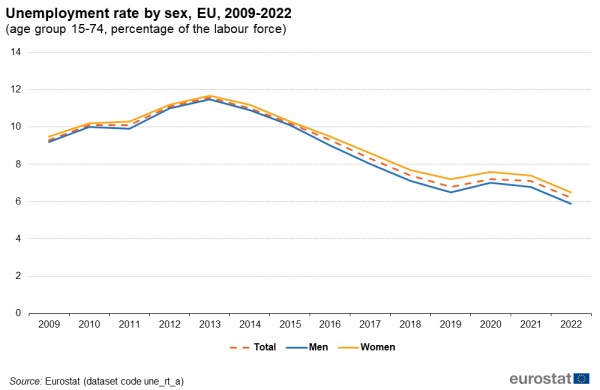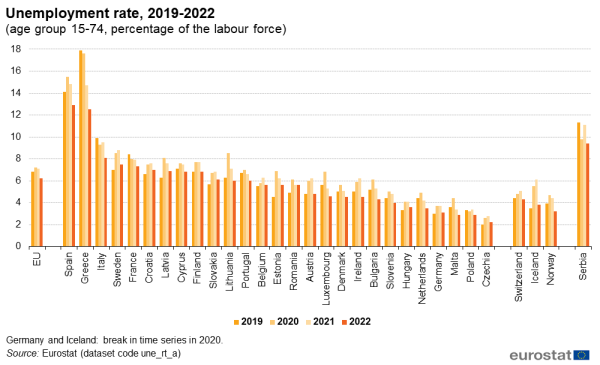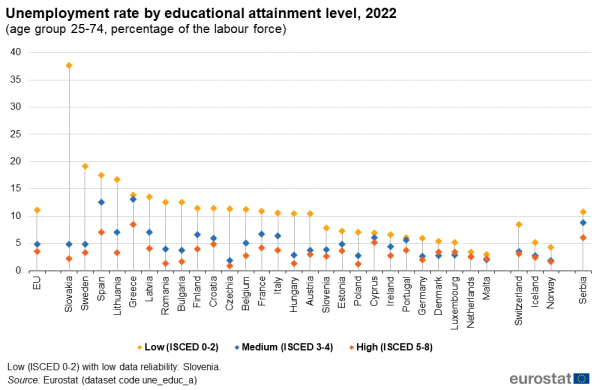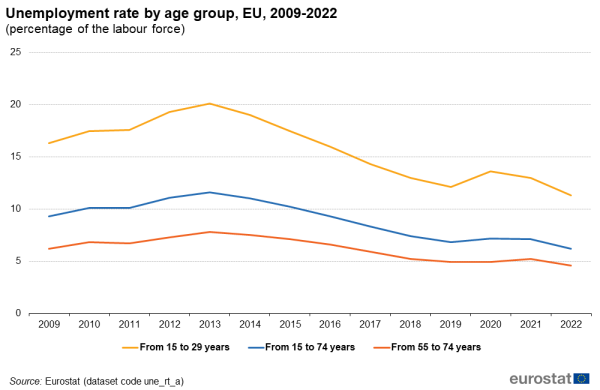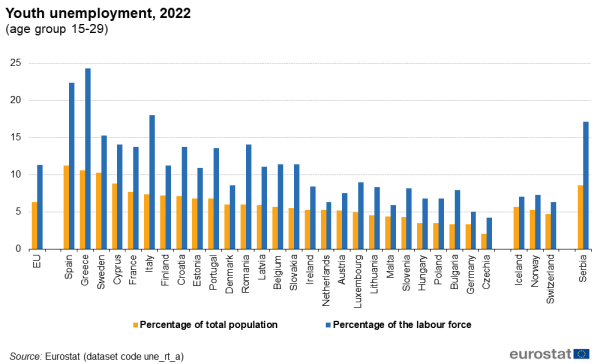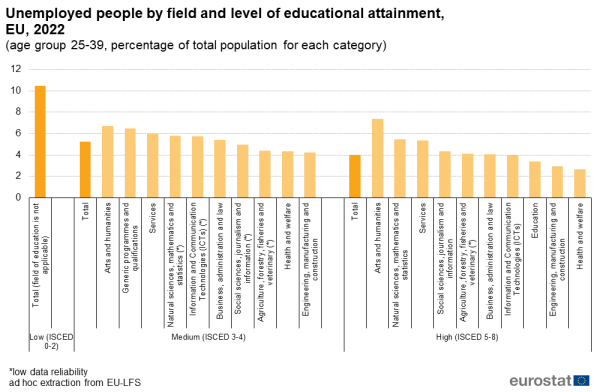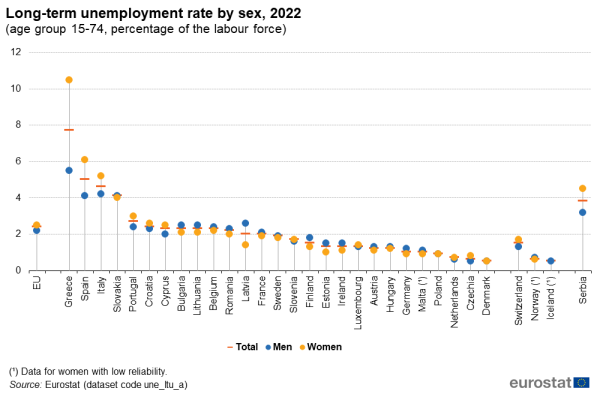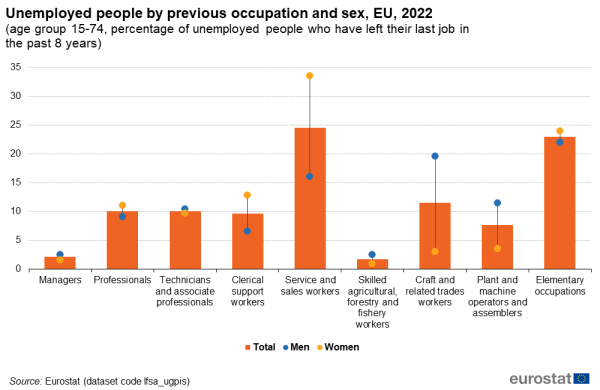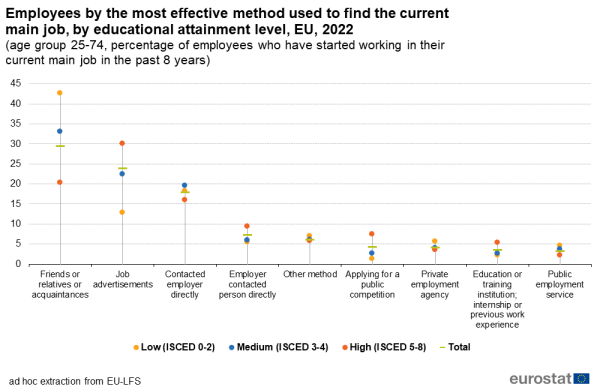Unemployment statistics and beyond
Data extracted in May 2023.
Planned article update: June 2024.
Highlights
This article focuses on annual statistics on unemployment in the European Union (EU) and its individual Member States, as well as three EFTA countries (Iceland, Norway, and Switzerland) and one candidate country (Serbia).
A separate article on unemployment statistics presents the unemployment figures on a monthly basis. An article on labour market slack - employment supply and demand mismatch is also available, focusing on the three measures of labour market attachment that supplement the unemployment rate.
Unemployment levels and rates move in a cyclical manner, largely related to the general business cycle. However, other factors such as labour market policies and demographic changes may also influence the short and long-term development of unemployment.
Full article
Trends in the unemployment rate
In 2022, the unemployment rate in the EU for people aged 15-74 years reached a historic low of 6.2 %, marking the lowest rate since 2009 (see Figure 1). Please note that when calculating the unemployment rate, the denominator used is the labour force, which encompasses the total number of employed and unemployed people of the same age group. Over six consecutive years from 2014 to 2019, the unemployment rate steadily declined. This was followed by a slight increase of 0.4 percentage points (pp) in 2020 (due to the COVID-19 pandemic). Then, the EU unemployment rate decreased by 0.1 pp in 2021 and a further 0.9 pp in 2022.
In 2022, in the EU there were 6.7 million unemployed men and slightly fewer unemployed women, amounting to 6.5 million. Despite the lower number of unemployed women, they represented 6.5 % of the female labour force, whereas unemployed men accounted for a lower percentage - at 5.9 % - of the male labour force. Figure 1 above illustrates that women consistently experienced higher unemployment rates than men since 2009.
In 2022, women in 14 out of the 27 EU Member States had higher unemployment rates than men (see Figure 2). Among these countries, Greece recorded the most significant gender difference, with a 16.4 % unemployment rate for women compared with 9.3 % for men (a gap of 7.1 pp). Poland recorded equal unemployment rates of 2.9 % for both men and women. In the remaining 12 EU Member States, the unemployment rate for men surpassed that of women with Latvia showing the most pronounced difference, with a male unemployment rate of 8.1 % compared with 5.6 % for women (a 2.5 pp gap).
Figure 3 displays the national unemployment rates from 2019 to 2022 (total of men and women). Between 2019 and 2020, the national unemployment rates increased in 23 of the 27 EU Member States. Between 2020 and 2021, the unemployment rate dropped in 15 EU Member States, while it increased in 9 and remained stable in 3. Subsequently, there was a decline in the unemployment rate across most countries from 2021 to 2022, except Romania, which maintained a steady unemployment rate of 5.6 % during this last period.
Greece, Spain, and Ireland witnessed the most significant reductions in unemployment rates between 2021 and 2022, with decreases of 2.2 pp, 1.9 pp, and 1.7 pp, respectively. Nonetheless, in 2022, Spain (12.9 %) and Greece (12.5 %) had the highest unemployment rates in the EU, standing at almost 13 %, while Poland (2.9 %), Malta (also 2.9 %), and Czechia (2.2 %) stood out with the lowest rates, all below 3 %.
Unemployment rate by level of education
The unemployment rate varies significantly across the different levels of educational attainment (see Figure 4, 2022 results for people aged 25-74 years). Generally, as educational attainment increases, the unemployment rate decreases. This holds in the majority of countries, except for Denmark, Luxembourg, and Malta, where people with a high level of education experience higher unemployment rates compared with those with a medium level. Also, the Netherlands exhibits equal rates of unemployment for people with medium and high levels of education.
To illustrate these findings, the highest unemployment rates in the EU were recorded for those with a low level of education, reaching 37.7 % in Slovakia, 19.2 % in Sweden, and 17.5 % in Spain. Conversely, the lowest rates, below 1.5 %, were found among the labour force with a high level of education, namely in Romania, Hungary, Poland, and Czechia.
Unemployment rate by degree of urbanisation
Figure 5 illustrates the unemployment rate for people aged 15-74 years across different degrees of urbanisation in 2022, revealing distinct patterns among countries. In eastern European countries Croatia, Slovakia, Lithuania, Romania, Bulgaria, Hungary, and Poland, the highest rates were recorded for people living in rural areas. Conversely, other countries, the majority in the EU, experienced their highest national unemployment rates in either cities or towns and suburbs. For instance, Belgium and Austria recorded substantially higher unemployment rates for people in cities compared with those residing in other areas, and in Greece, the unemployment rate for those living in towns and suburbs surpassed that of both residents of cities and rural areas.
Youth unemployment
Figure 6 shows a consistent trend in the EU, demonstrating that the unemployment rate for young people aged 15-29 years consistently exceeded the overall unemployment rate (for people aged 15-74 years) since 2009. Conversely, the unemployment rate for people aged 55-74 years consistently remained lower than the overall unemployment rate throughout the same period.
The high rates of youth unemployment reflect the challenges faced by young people in securing employment. However, it is important to note that this does not necessarily imply a substantial number of unemployed people aged 15 to 29 years. Many young people, unlike their older counterparts, are engaged in full-time studies and are not actively seeking employment or included in the labour force, used as a denominator to calculate the unemployment rate. To address this, an alternative indicator is calculated for analytical purposes: youth unemployment ratio. This ratio represents the proportion of unemployed young individuals within the total youth population.
Figure 7 indicates that the youth unemployment ratio in the EU stood at 6.3 % for the year 2022, indicating the proportion of unemployed people aged 15-29 years within the total population of the same age. If we take as a denominator only those young people participating in the labour force, we reach a youth unemployment rate of 11.3 %. For comparison, unemployed people aged 30-74 years represented 3.4 % of the total population and 5.0 % of the labour force of the same age group.
Across the EU Member States, the youth unemployment ratio varied from 2.0 % in Czechia to 11.2 % in Spain, while the youth unemployment rate ranged from 4.2 % in Czechia to 24.3 % in Greece.
It is worth noting that in some countries the values of the rate and ratio are closer to each other than in others, meaning that in some instances young people in the labour force overlap more closely with the total population of the same age. See for example Germany, Malta, and the Netherlands, where the difference between the youth unemployment rate and the youth unemployment ratio is less than 2 pp. By contrast, this difference exceeds 10 pp in Greece, Spain, and Italy.
Figure 8 shows the percentage of unemployed people in the EU aged 25-39 years among the total population of the same age, split by field and level of education.
Firstly, looking at the different levels of education, unemployed people aged 25-39 years represented a higher proportion among people with a low level of education (10.4 %), compared with those with a medium level of education (5.2 %), who reported a higher percentage than those with a high level of education (4.0 %).
Focusing on the different fields of education, the percentage of unemployed people aged 25-39 years was the highest for those who graduated in the field of arts and humanities. Specifically, among those with a medium level of education, this percentage stands at 6.7 %, whereas it rises even further to 7.4 % for people with a high level of education.
On the other hand, the lowest percentages of unemployment among the total population aged 25-39 years were registered among those who graduated in the field of health and welfare (4.3 % for medium and 2.7 % for high level of education), as well as in the field of engineering, manufacturing and construction (4.2 % for medium and 2.9 % for high level of education).
Long-term unemployment
The long-term unemployment rate, which represents the percentage of people unemployed for 12 months or more within the labour force, is displayed in Figure 9. The age group in focus is 15-74 years. Greece stood out with the highest long-term unemployment rate in the EU, reaching 10.5 % for women and 5.5 % for men. Spain followed with the second highest rate, where women experienced a rate of 6.1 % and men 4.1 %. These two countries demonstrated the most pronounced gender difference, with women facing significantly higher rates than men. Italy ranked third, reaching 5.2 % for women and 4.2 % for men.
On the other end of the scale, Poland, the Netherlands, Czechia, and Denmark reported the lowest long-term unemployment rates within the EU, with rates below 1 % for both men and women. Notably, Poland and Denmark had no gender difference in the long-term unemployment rate, as men and women experienced equal percentages.
At EU level, the long-term unemployment rate was 2.2 % for men and slightly higher at 2.5 % for women.
Figure 10 shows the breakdown of unemployed people by unemployment duration. At EU level, about a quarter (23.4 %) have been unemployed for a period of 24 months or more (i.e. classified as very long-term unemployment). However, this average hides substantial differences between countries. Almost half (46.1 %) of the unemployed people in Slovakia had been looking for a job for 24 months or more. Greece and Italy followed with relatively high percentages, respectively 41.5 % and 40.6 %. By contrast, less than 10 % of the unemployed in Estonia, Malta, and Denmark have been in this situation for such a period. Note that Malta had a relatively high percentage of unemployed people from 12 to less than 24 months.
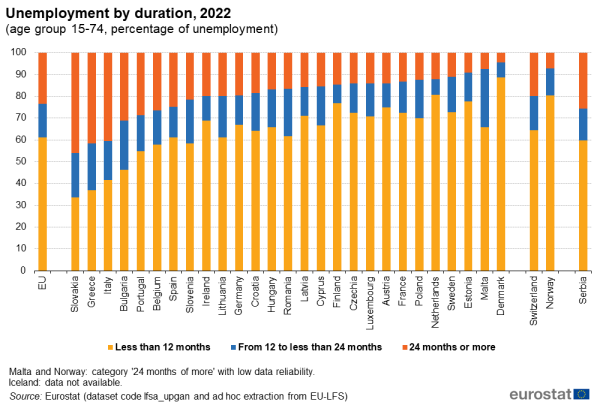
Source: Eurostat (lfsa_upgan) and ad hoc extraction from EU-LFS
Previous occupation
Figure 11 provides insights into the occupation of unemployed people in their last job. Note that the data on the previous occupation is available only for those previously in employment and left their last job within the past 8 years. The statistics reveal the percentage of each occupational group (ISCO-08) within this population at EU level. It shows that almost a quarter (24.5 %) had been previously employed as service and sales workers, while another 23.0 % had worked in elementary occupations such as cleaners, helpers, or food preparation assistants. By contrast, only 1.7 % had previously been skilled agricultural, forestry and fishery workers, and 2.1 % had been managers.
Significant differences between men and women are apparent. Service and sales workers constituted 16.0 % of unemployed men, whereas this group made up 33.5 % of unemployed women. The difference is also large but takes the opposite direction for those who had previously worked in craft and related trades: 19.5 % of unemployed men held a profession in this occupational group, whereas the corresponding percentage of women was only 3.0 %.
Methods to find a job
The article concludes with information on the most effective methods to find a job.
In total, 29.5 % of employees in the EU aged 25-74 years said that relying on friends, relatives or other acquaintances had been the most effective method to find their current job (see Figure 12). Information for the most effective method to find a job is available only for those who started their current main job within the past 8 years. This percentage varies a lot according to the level of education: 42.6 % for those with a low level, against 20.3 % for those with а high level of educational attainment.
Among the various methods, job advertisements ranked with the second highest percentage, as 23.9 % considered them as the most effective to find their current main job. As opposed to the personal connections, the percentage of job advertisements was much higher among those with a high level of education (30.1 %), than among those with a low level (12.9 %).
The following methods were the least effective, with less than 5 % considering them as the most effective to find their current main job: applying for a public competition, relying on private employment agency, educational or training institution (including internship or previous work experience), or relying on public employment service.
Source data for tables and graphs
Methods and definitions
Data sources
All figures in this article are based on the European labour force survey (EU-LFS).
Source: The European Union Labour Force Survey (EU-LFS) is the largest European household sample survey providing quarterly and annual results on labour participation of people aged 15 years and over as well as on persons outside the labour force. It covers residents in private households. Conscripts in military or community service are not included in the results. The EU-LFS is based on the same target populations and uses the same definitions in all countries, which means that the results are comparable between the countries. The EU-LFS is an important source of information about the situation and trends in the national and EU labour markets. Each quarter around 1.8 million interviews are conducted throughout the participating countries to obtain statistical information for some 100 variables. Due to the diversity of information and the large sample size, the EU-LFS is also an important source for other European statistics like Education statistics or Regional statistics.
Please note that Eurostat provides two sets of indicators linked to the annual unemployment rate, which serve different purposes and which in some cases differ from each other:
1) The LFS main indicators, which contain seasonally adjusted series. They include the labour market headline indicators used e.g. in the Macroeconomic Imbalance Procedure Scoreboard or the European Statistical Recovery Dashboard and are consequently used for monitoring policy. They only have a few breakdowns and normally refer to the age group 20-64 years.
2) The detailed results, which contain series that are not seasonally adjusted. They have a large number of breakdowns and can therefore be used for more detailed analysis. For France, only one data series is published. This series contains data for metropolitan France until the fourth quarter of 2013, and from 2014 on, also the French overseas departments.
Reference period: Yearly results are obtained as averages of the four quarters in the year.
Coverage: The results from the EU-LFS currently cover all European Union Member States, the EFTA Member States Iceland, Norway and Switzerland, as well as the candidate countries Montenegro, North Macedonia, Serbia and Türkiye. For Cyprus, the survey covers only the areas of Cyprus controlled by the Government of the Republic of Cyprus.
European aggregates: EU and EU-27 refer to the sum of the 27 EU Member States. If data are unavailable for a country, the calculation of the corresponding aggregates takes into account the data for the same country for the most recent period available. Such cases are indicated.
Country notes
In the Netherlands, the EU-LFS data remains collected using a rolling reference week instead of a fixed reference week, i.e. interviewed persons are asked about the situation of the week before the interview rather than a pre-selected week.
Definitions
The concepts and definitions used in the EU-LFS follow the guidelines of the International Labour Organisation (ILO).
Unemployment
Eurostat publishes unemployment statistics based on a definition of unemployment provided by the ILO for which there are three criteria, namely:
- being without work;
- actively seeking work;
- and being available for work.
The ILO definition of the unemployment rate is the most widely used labour market indicator because of its international comparability and relatively timely availability. Besides the unemployment rate, indicators such as employment and job vacancies also give useful insights into labour market developments.
Monthly unemployment figures are published by Eurostat as rates (as a percentage of the labour force) or levels (in thousands), by sex and for two age groups (persons aged 15 to 24 years, and those aged 25 to 74 years). The figures are available as unadjusted, seasonally adjusted and as a trend series. The time series for data for the EU and the euro area (EA-19) aggregates start in 2000; the starting point for individual EU Member States varies.
Quarterly and annual unemployment figures from the EU-LFS are published with more detailed breakdowns (for example, a wider range of age groups, by nationality, or by educational attainment); there are also figures available on long-term unemployment (unemployed for more than 12 months) and very long-term unemployment (unemployed for more than 24 months).
Unemployment rates are also presented according to the educational attainment level of the population, i.e. the highest level of education successfully completed. The different levels of educational attainment are defined by the United Nations International Standard Classification of Education (ISCED 2011). Low level of educational attainment refers to ISCED levels 0-2 (lower than primary, primary and lower secondary education), medium level refers to ISCD levels 3 and 4 (upper secondary and post-secondary non-tertiary education) and high level refers to ISCED levels 5-8 (tertiary education).
Underemployment and potential additional labour force
Many persons only partially fulfil the three unemployment criteria above and are therefore not considered as unemployed. In order to provide information on people who are not unemployed, Eurostat also publishes indicators on the following groups.
- Underemployed part-time workers: persons working part-time who wish to work additional hours and are available to do so.
- The potential additional labour force: jobless persons who want to work and are either available to work or are searching for work but not both at the same time. This group includes, among others, discouraged job seekers and persons prevented from job seeking due to personal or family circumstances. This group is split into two groups: persons seeking work but not immediately available and persons available to work but not seeking work.
Time series
Regulation (EU) 2019/1700 came into force on 1 January 2021 and induced a break in the EU-LFS time series for several EU Member States. In order to monitor the evolution of employment and unemployment despite the break in the time series, EU Member States assessed the impact of the break in their country and computed impact factors or break corrected data for a set of indicators. Break corrected data are published on the Eurostat website for the LFS main indicators.
Additional methodological information
More information on the EU-LFS can be found via the online publication EU Labour Force Survey, which includes eight articles on the technical and methodological aspects of the survey. The EU-LFS methodology in force from the 2021 data collection onwards is described in methodology from 2021 onwards. Detailed information on coding lists, explanatory notes and classifications used over time can be found under documentation.
Context
The unemployment rate is an important indicator with both social and economic dimensions. Rising unemployment results in a loss of income for individuals, increased pressure with respect to government spending on social benefits and a reduction in tax revenue. From an economic perspective, unemployment may be viewed as unused labour capacity.
Time series for unemployment are used by the European Commission, other public institutions, and the media as an economic indicator, while banks may use the data for business cycle analysis. Finally, there is interest among the general public for information concerning unemployment.
The unemployment rate is considered to be a lagging indicator. When there is an economic downturn, it usually takes several months before the unemployment rate begins to rise. Once the economy starts to pick up again, employers usually remain cautious about hiring new workers and it may take several months before unemployment rates start to fall.
Male, youth and long-term unemployment appear to be more susceptible to cyclical economic changes than overall unemployment. Indeed, social policymakers often face the challenge of remedying these situations by designing ways to increase employment opportunities for various groups of society, those working in particular economic activities, or those living in specific regions.
Globalisation and technological developments appear to have an ever-increasing effect on daily life, and the demand for different types of labour and skills changes, sometimes at a rapid pace. While enterprises try to improve their productivity and become more competitive and innovative, they may well seek to pass on risk to the labour force through greater flexibility — both in relation to those already in employment, as well as those searching for a new job. Within the context of the European employment strategy (EES), there are a number of measures that are designed to help encourage people to remain in work or find a new job, including: the promotion of a life-cycle approach to work, encouraging lifelong learning, improving support to those seeking a job, as well as ensuring equal opportunities.
Direct access to
- Labour force survey in the EU, EFTA and candidate countries — Main characteristics of national surveys, 2020, 2022 edition
- Quality report of the European Union Labour Force Survey 2020, 2022 edition
- EU labour force survey — online publication
- European Union Labour force survey - selection of articles (Statistics Explained)
- LFS main indicators (t_lfsi)
- Unemployment - LFS adjusted series (t_une)
- LFS series - detailed annual survey results (t_lfsa)
- Unemployment rates of the population aged 25-64 years by educational attainment level (tps00066)
- LFS main indicators (lfsi)
- Unemployment - LFS adjusted series (une)
- LFS series - detailed quarterly survey results (from 1998 onwards) (lfsq)
- Total unemployment - LFS series (lfsq_unemp)
- LFS series - Detailed annual survey results (lfsa)
- Total unemployment - LFS series (lfsa_unemp)
Publications
- EU labour force survey — online publication
- Labour force survey in the EU, EFTA and candidate countries — Main characteristics of national surveys, 2020, 2022 edition
- Quality report of the European Union Labour Force Survey 2020, 2022 edition
- Statistical working papers / Manuals and guidelines
ESMS metadata files and EU-LFS methodology
- Employment and unemployment (Labour Force Survey) (ESMS metadata file — employ_esms)
- LFS main indicators (ESMS metadata file — lfsi_esms)
- LFS series - detailed annual survey results (ESMS metadata file — lfsa_esms)
- LFS series - detailed quarterly survey results (from 1998 onwards) (ESMS metadata file — lfsq_esms)
- LFS ad-hoc modules (ESMS metadata file — lfso_esms)
- Unemployment by sex and age – monthly data (ESMS metadata file — une_rt_m_esms)
- LFS regional series (ESMS metadata file — reg_lmk_esms)
